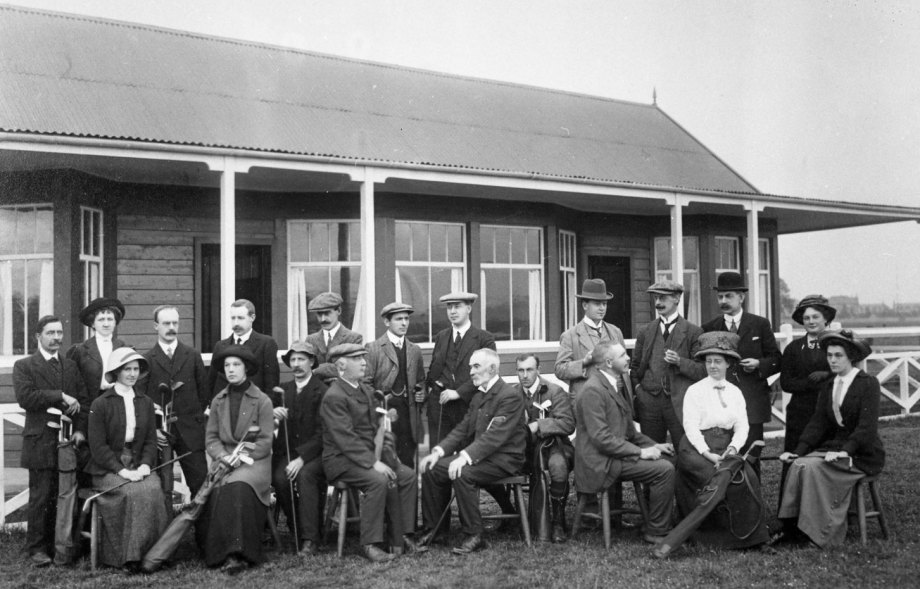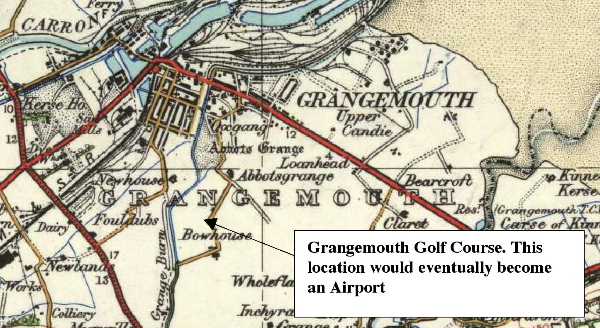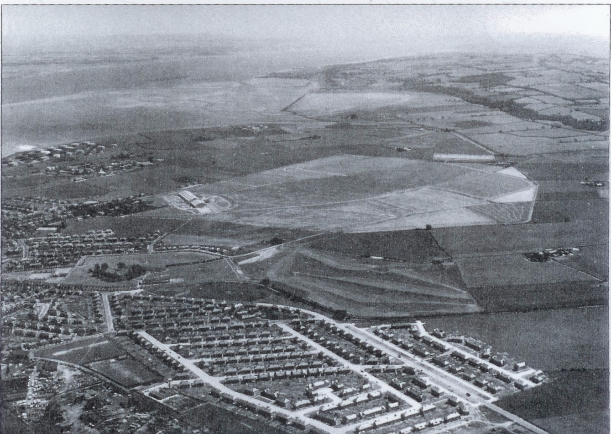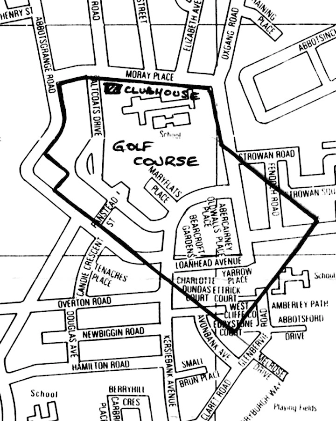
Grangemouth.
Grangemouth Golf Club. “A number of local men met on Thursday night to consider the advisability of forming a golf club for Grangemouth. It was unanimously agreed that the initial steps be taken towards that object, and a committee of four was appointed to make the necessary enquiries with a view to obtaining the use of lands on Abbots Grange, in the vicinity of the Public Park.”
(FH 17.5.1899)
As can be seen below, this plan was never proceeded with.
"A meeting in connection with the golf club was held in the Lesser Town Hall on Tuesday evening – Provost Mackay presiding over a large attendance of members.
A report by the committee stating the present progress of the work was submitted, from which it appeared that all the greens had been prepared, and that everything would be in order for the opening on 28th inst.
On the motion of Mr Mackenzie it was unanimously agreed to approve of the trustees nominated by the committee for the club, and authorise them to sign the lease of the ground for and on the behalf of the club.
The draft constitution as revised and approved of by the committee was submitted by the secretary, and received the meetings approval and acceptance.
A remit was made to the lady members to form a committee of their own, consisting of Captain, secretary, and four members, and the general committee were entrusted with the completion of arrangements in connection with the opening of the course."
(FH 14,8,1909)
Formation of Golf Club
Grangemouth Golf Club Instituted 1909. “With the present formation of a golf course in Grangemouth, a long cherished desire has at long last been met.
As far back as fifteen years ago such a project was spoken of, and at various times since then efforts have been made to give practical effect to the proposal; but the support accorded was not such as justified its promotion. This was due to various causes, but chiefly perhaps to the fact that the game of golf had not attained to such prominence in the recreation world, nor did it engage the attention of the people to such an extent as it does to-day.
In more recent times, however, golf as a pastime has become very popular with a large section of the community of Grangemouth, and accordingly when, some four months ago, a number of gentlemen again set a movement on foot for the formation of a golf course, they enlisted the support of a large number of enthusiasts, and subsequent efforts have culminated in the formation of a golf club and the laying out of a nine hole course, which will be opened in the course of a week or so. A small committee was at first appointed to secure suitable ground for the course. After full consideration, the grounds at Abbotsgrange were decided upon as the most suitable, and negotiations were entered into whereby these were ultimately secured and a long-term lease agreed.
The course is situated on two fields on the farm of Abbotsgrange, at present tenanted by Mr Shaw, Dairyman, Abbotsgrange, and Mr Marshall, farmer, Fouldule, extending to 42 acres, and bounded on the one side by Abbotsgrange Road and on the other side by the road leading to Polmont. It has a very central situation, being only some ten minutes walk from the station and within 5 minutes walk from the principal residential parts of the town.
The total distance over the whole course exceeds 1 ½ miles, and the ground is almost level. There is a natural hazard in the centre in the form of a burn, dividing the two fields over which the course extends, which has been piped at intervals to allow of a passage between the two fields. In order to make the course a little more sporting in character, a few artificial hazards have been introduced, and the ground laid out to the best advantage, the primary object in view being the acquisition of a thoroughly equipped course such as will compare favourably with any other of similar dimensions, and provide additional attractions in the town. The distances between the holes vary ranging from 106 to 460 yards. The putting greens have been formed on the old sward and with beating, rolling, sanding, and cutting, a good surface has been obtained. The teeing greens have been raised about 8 or 9 inches above the original level of the ground, which, in addition to affording a good stand for the drive, is calculated to be very serviceable from a drainage point of view. The fairways between the putting and teeing greens have been cut, rolled and mowed, and there also a good surface has been obtained. Mindful of the variable elements and in order to make adequate provision for the players against the “ Sudden Blast,” a small shelter has been erected at the Eastern boundary, or the extreme point of the course.
In the construction of the passes across the burn dividing the fields the erection of the shelter, and other necessary adjuncts, a great deal of timber has been used, and which, it may be mentioned was gratuitously given by the Vice President. On the invitation of the committee, Mr David A Donald, Burgh Surveyor, accepted the oversight of the construction of the course, and he has carried out the work in a most expeditious and efficient manner, and entirely outwith the time devoted to his official duties. Such indeed has been the progress of the work that the course is being opened earlier than was at first anticipated. Our reproduction above is from a sketch prepared by Mr Donald.
The course is pre-eminently situated for commanding a view of the surrounding district. Viewed from almost the centre in a Northerly direction is observed the bold outline of the Ochil Range, with Dumyat, Ben Cleuch, and King’s Seat, the loftiest peaks of the range, towering in majestic prominence. The Saline Hills run almost contiguous in an Easterly direction, with Culross Abbey in grim majesty on the slopes, and Dunfermline, the seat of the linen industry, nestling in the valley. The rising town of Bo’ness obtains a prominent position in a South- Easterly direction, and in close proximity, but at a more Southerly point, the thickly wooded polices of Kinneil with the romantically associated Kinneil House in the centre can be observed. Bonnytoun Hill, or as it is familiarly called, Glower O’er-em, a peak 559 feet above sea level, containing a monument to Brigadier-General Adrian Hope, who fell in the Indian Mutiny, is next to attract the attention, while almost directly South Cockold-Le-Roi, a mutual border between Linlithgow and Torphichen parishes, soaring to an altitude of 912 feet above sea level, commands a prominent position. Under its shadow is the ancient and historic town of Linlithgow. In the same direction a glimpse of Polmont village is obtained, while Polmont church is clearly visible, and at a still higher altitude Shieldhill and Wallacestone are brought into view. In the foreground of the land to the South of the course a strong border line of richly wooded polices add to the picturesqueness of the ground, with the terracing slopes behind. Departing from what is commonly referred to as the “ Heights,” and looking in a more Westerly direction, the village of Laurieston is observed at the foot of the Callander woods, and a little farther round, Falkirk is brought into view. Campsie Fells, with Ben Lomond in the background are seen in a North-Westerly direction, and with clear atmospheric conditions a glimpse can be caught of the Grampians, while Ben Ledi is continuously in sight. From the situation of the course an excellent view is obtained of the town, embracing the docks, Bo’ness Road, and the various public buildings of the new town.
Arrangements have been made for Provost Mackay declaring the course open. Mrs Mackay is expected to drive off the first ball, and John Duncan, Professional, and Mr A.M. Swan, secretary, both of Stirling golf club, will give an exhibition game.” (FH 21.8.1909)
Opening of the course
"The opening of the recently formed golf course at Grangemouth, which took place on Saturday afternoon as the beginning of a new era in the history of the town, and marks the practical attainment of a desire which has existed for the last fifteen years, and relatively increased with the growing popularity of the game of golf. As against the few who fifteen years ago were enthusiastic golfers, and first mooted the proposal for a golf course, there is to be found to-day close on two hundred ladies and gentlemen, who, by having become members of the club, have shown their interest in the game, and equally contributed to the phenomenally successful result in converting the proposal into real accomplishment.
It is only some four months as we have already stated, since the present movement was set on foot, and that it should have been so effectively carried out that a nine hole course was laid out and formally opened on Saturday, and the new club formed with a membership of 184, comprising 113 gentlemen, 67 ladies, and four boys, furnishes evidence not only of the popularity of the ancient game, but of consistent preparatory efforts.
The formation of the course, which is situated on the grounds of Abbotsgrange, covering two fields of 42 acres, and a mileage of 1.60, was almost wholly entrusted to Mr Donald, Burgh Surveyor, on the invitation of the committee, and he forwarded the work in a manner which reflected great credit on himself, and surpassed the most sanguine expectations of the committee.
The opening ceremony was performed before a very large attendance of ladies and gentlemen in favourable weather, although as the afternoon advanced, and while an exhibition game was in progress, there was a heavy shower of rain." (FH 4.9.1909)
“The new clubhouse of the Grangemouth Golf Club was formally opened on Saturday afternoon. Brilliant weather favoured the ceremony, and a large and influential company of members and friends turned out for the occasion. Ex-Provost A Y Mackay, president of the club, performed the opening ceremony.
Mr Williamson, captain of the club, in calling upon Mr Mackay to open the new clubhouse, said that the club continued to prosper. There were around 220 members at the present time, which was thought very satisfactory considering the club was only about three years old. He was sure that those who had helped in the bazaar held last December would be very pleased to see the fruits of their labour in the new clubhouse before them.
Ex-Provost Mackay said that the golf club supplied a felt want in Grangemouth. It was a game that revived their minds and was a means of sustaining social intercourse among the people of the Port. They had a clubhouse to start with, but it was found to be inadequate. He thought it must be a source of satisfaction , not only to the ladies who had helped at the bazaar, but to the gentlemen and also the Building Committee, to see this new clubhouse now finished.
Ex-Baillie Gilmour asked the members to accord a hearty vote of thanks to those gentlemen who had helped the club; Ex-Provost Mackay who had given a club-room table and chairs; Mr John M Wilkie, a complete flagstaff; Provost Wood, club-room clock and flags; Mr David Kerr, grate for the club-room and “Golf Monthly” for the club-room table; Mr Binnie, secretary, two collapsible tables; Mr John Tennant, urns and crockery; Mr James Robertson, “World of Golf” for the club-room table.”
(FH 4.5.1912)
Clubhouse destroyed by fire
"The destruction of the clubhouse at Grangemouth, referred to elsewhere, is most unfortunate. The club has now to look forward to the building of a new house, but the greatest sympathy, we fancy, will extend to the players who have lost their clubs. Fortunate were those who had taken their clubs away for the week end, but some 200 sets, it is understood, have disappeared in the flames. To each individual it means considerably more than the value of the “ Sticks” although that will run round about a five pound note. It is not always possible to replace a favourite club, and many old favourites are gone." (FH 10.5.1924)
“The Central Scotland airport to be built at Grangemouth is to be ready for service on May 1.Six farms on the Abbotsgrange estate have been purchased and are to be developed immediately..
A portion of the local golf course comes within this area, and it is proposed that a portion of the undeveloped ground purchased by the Aerodrome Company will be available for the golf course, as the clubhouse and certain fairways do not come within the radius of the airport.” (S 4.2.1939)
New Grangemouth Course
"Mr James Binnie, the oldest original member of Grangemouth Golf Club, drove the first ball off the tee when the new nine hole course was formally opened on Saturday afternoon.
Dr J.G. A nderson, the President of the club, in declaring the course open, pointed out that the formation of the new course had been necessitated by the taking over the old 18 hole course by Scottish Aviation Ltd, for building an aerodrome. There were only nine holes on the new course, but they were longer than those of the old, and there was almost as much room as formerly. Two holes were all that was left of the old course, and the remaining seven had been constructed on two adjoining fields that had been secured.
The first ball was driven well down the fairway, and was recovered by Master Andrew McQueen, a juvenile member, who was rewarded when he returned the ball to Mr Binnie.
Following the ceremony, a mixed foursomes match between teams representing the President and Vice President were played." (S 10.4.1939)
“The 9 hole course is very flat. Par 35(18 holes)” (SGC Mar 1947).
“Grangemouth golf club may shortly have to sacrifice two holes of its nine hole course. It is understood that the education committee of Stirling County Council propose to take over the ground for the erection of a new junior secondary school for the town. The ground is the property of the air ministry, whose approval will be required. An official of the club said this week that he did not want to precipitate anything by hasty comment at this stage.
If the club lost the two holes then they would no longer have a course in the accepted sense. There had been a mention of a field being given to them in replacement, but everything was in a delicate state of negotiation.
Officials of both Stirling County Council and Grangemouth Town Council declined to comment on the proposed take-over. It was admitted at Stirling that a matter of this nature is before the education committee, but nothing further could be stated. It is understood that most, if not all, members of Grangemouth Town Council are opposed to the take-over, but the difficulty appears to be the lack of any other suitable site for the new school” (FH 26.5.1951).
“Grangemouth Golf Course, which has lain under a threat of being robbed of its first and last greens for the building of a junior secondary school, has been granted a brief reprieve.
A housing and town planning committee minute records the decision of a joint meeting with the County Council, that the school be built on a site immediately East of the first and last holes, extending further than was originally intended on to the airfield surface. It was proposed, however, that an alternative site be found eventually for the two holes, and that the area should be used for private housing development.” (FH 8.12.1951)
“Grangemouth golf course, now owned by the Town Council and earmarked as a housing development area, will be available for play this year, but when the course is taken over in April 1955, a transfer of members to a new nine-hole course at Polmont is likely. There the Town Council have bought a mansion and 43 acres known as Polmont Bank where a new nine-hole course will be laid out. The council have an option to rent a further 35 acres and are negotiating for 15 acres more with a view to providing golfing facilities for players in the area at an 18-hole municipal course. Grangemouth golf club are likely to ask the council for permission to run a private golf club on the new course.” (GH 29.3.1954)
The Council, compulsorily purchased the golf course for housing development in 1952. The airfield which had been taken over by the Air Ministry during WW2, remained in service until 1955, when it was closed. Some of the land went to the Oil Refinery, and the rest for housing development.
The current municipal golf club was opened in 1974 at Polmonthill.


